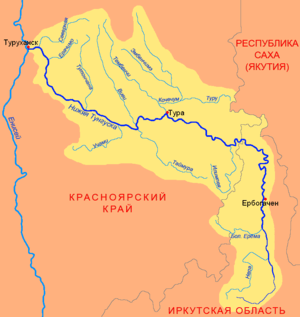Tembenchi River

The Tembenchi River (Russian: Тембенчи) is a major river of Krasnoyarsk Krai in Siberia, central Russia, joining the Kochechum River to the northwest of Tura. The river, which has its source in the Putorana Plateau at 67°36′9″N 94°22′48″E / 67.60250°N 94.38000°E, is 571 kilometres (355 mi) long, and its basin covers 21,600 square kilometres (8,300 sq mi).[1][2]
The river runs through a remote, sparsely inhabited mountainous region with a very severe climate; there is no vegetation, except mosses, lichens and herbs. Like all Siberian rivers, it suffers from long periods of frost for six to seven months a year, from late October to May, and large tracts of land remain permanently frozen at depth. The river is fed mainly by snowmelt and its high water lasts from late May through until September.[2] Its lower course is characterised by basalts, draining a narrow and rather deep valley of the northwest of the Central Siberian plateau known as Syverma Plateau.[3] The river in its upper course flows through two lakes, one of which is Lake Tembenchi, which is nearly 50 kilometres (31 mi) long. Then the river passes the towns of Burungda and Tembenchi on the way to Tura, where it joins the Kochechum at 64°36′32″N 99°55′46″E / 64.60889°N 99.92944°E to the northwest.
References
- ↑ Akademii͡a︡ nauk SSSR. (1945). Comptes rendus (Doklady) de l'Académie des sciences de l'URSS. L'Académie. p. 424. Retrieved 16 February 2012.
- 1 2 Aleksandr Mikhaĭlovich Prokhorov (1982). Great Soviet Encyclopedia. Macmillan. p. 500. Retrieved 16 February 2012.
- ↑ Institut geokhimii i analiticheskoĭ khimii im. V.I. Vernadskogo; Aleksandr Pavlovich Vinogradov; Nikolaĭ Ivanovich Khitarov (1969). Problems of geochemistry. Israel Program for Scientific Translations [available from the U.S. Dept. of Commerce, Clearinghouse for Federal Scientific and Technical Information, Springfield, Va.] Retrieved 16 February 2012.